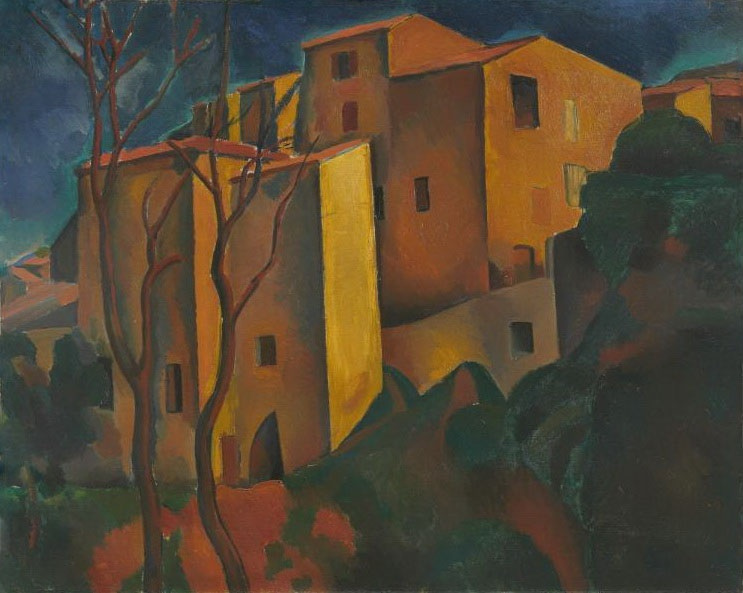log in
Enter site
Login to use Arthive functionality to the maximum
The Old Town, Cagnes
Andre Derain • Painting, 1910, 66×82 cm
Description of the artwork «The Old Town, Cagnes»
André Derain was an indefatigable experimenter and was constantly on the lookout, never staying in a single style for long. Impressionism, Fauvism, Neoclassicism, Gothic motifs are just an incomplete list of his searches. The Old Town, Cagnes painting was created during his brief fascination by Cubism.
Cubism attracted him in its early, cézannist interpretation. At this time, Derain had considerably muffled his violent fauvist palette, objects in his pictures became voluminous, structured, a clear geometry and a specific reverse perspective began to appear. At these years, he loved all shades of brown and ocher combined with dark tones of blue and green (1, 2, 3).
The small town of Cagnes-sur-Mer, located in the South East of France in the picturesque Provence-Alpes-Côte d'Azur region, was very popular with many famous artists. Auguste Renoir, Amedeo Modigliani, Chaim Soutine, Yves Klein lived and worked there. The foothills of the Alps in the north, the medieval Grimaldi castle in the old town, the Mediterranean in the south – the artists had plenty of things to put their eyes on.
Upper Cagnes, the historical part of the city, towering on the hill, which was closer to the Alps, attracted Derain. The ancient buildings with peaked roofs, crowded on medieval streets surrounded by evergreen foliage, perfectly blended with his favorite color scheme. The typically Cubist volumes, characteristic chiaroscuro and accents on the man-made objects make The Old Town, Cagnes resemble a still life à la Cezanne (1, 2).
But Derain would not have been himself, if he had remained within one style and had not introduced any foreign influences into him. As a memory from the era of Fauvism, he had a brilliant gift of a colorist, and he adopted laconic shapes and restrained palette from the Old Masters.
His affair with Cubism ended as swiftly as it began. While Picasso and Braque went on prowling into his jungle, picking objects to pieces and stacking them in pictures in an arbitrary order, Derain considered Cubism a dead-end branch of the evolution of painting. His disappointment was so great that he burned almost all his pictures of this period with his own hands and never returned to it.
Cubism attracted him in its early, cézannist interpretation. At this time, Derain had considerably muffled his violent fauvist palette, objects in his pictures became voluminous, structured, a clear geometry and a specific reverse perspective began to appear. At these years, he loved all shades of brown and ocher combined with dark tones of blue and green (1, 2, 3).
The small town of Cagnes-sur-Mer, located in the South East of France in the picturesque Provence-Alpes-Côte d'Azur region, was very popular with many famous artists. Auguste Renoir, Amedeo Modigliani, Chaim Soutine, Yves Klein lived and worked there. The foothills of the Alps in the north, the medieval Grimaldi castle in the old town, the Mediterranean in the south – the artists had plenty of things to put their eyes on.
Upper Cagnes, the historical part of the city, towering on the hill, which was closer to the Alps, attracted Derain. The ancient buildings with peaked roofs, crowded on medieval streets surrounded by evergreen foliage, perfectly blended with his favorite color scheme. The typically Cubist volumes, characteristic chiaroscuro and accents on the man-made objects make The Old Town, Cagnes resemble a still life à la Cezanne (1, 2).
But Derain would not have been himself, if he had remained within one style and had not introduced any foreign influences into him. As a memory from the era of Fauvism, he had a brilliant gift of a colorist, and he adopted laconic shapes and restrained palette from the Old Masters.
His affair with Cubism ended as swiftly as it began. While Picasso and Braque went on prowling into his jungle, picking objects to pieces and stacking them in pictures in an arbitrary order, Derain considered Cubism a dead-end branch of the evolution of painting. His disappointment was so great that he burned almost all his pictures of this period with his own hands and never returned to it.


